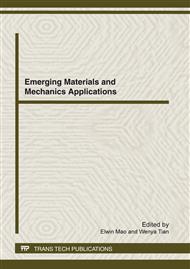[1]
Stanley E. Fawcett, Linda L. Stanley, Sheldon R. Smith. Developing a Logistics Capability to Improve the Performance of International Operations [J]. Journal of Business Logistics, 1997, 18 (2):101-127.
Google Scholar
[2]
Jeffrey S. Conant, Michael P. Mokwa, P. Rajan Varadarajan. Strategic Types, Distinctive Marketing Competencies and Organizational Performance: A Multiple Measures-Based Study [J]. Strategic Management Journal, 1990, 11 (5):365-383.
DOI: 10.1002/smj.4250110504
Google Scholar
[3]
Hongxin, Yang. Fiscal and tax policy research on adjustment of industrial structure [J] Communications in Computer and Information Science,2011,211(4): 401-407
DOI: 10.1007/978-3-642-23062-2_60
Google Scholar
[4]
Daniel F. Lynch, Scott B. Keller, John Ozment. The Effects of Logistics Capabilities and Strategy on Firm Performance [J]. Journal of Business Logistics, 2000, 21 (2):47-69.
Google Scholar
[5]
Sergio Olavarrieta, Alexander E. Ellinger. Resource-based Theory and Strategic Logistics Research [J]. International Journal of Physical Distribution & Logistics Management, 1997,27 (9/10) :559-587
DOI: 10.1108/09600039710188594
Google Scholar
[6]
David J. Closs, Morgan Swink, Anand Nair. The Role of Information Connectivity in Making Flexible Logistics Programs Successful [J]. International Journal of Physical Distribution & Logistics Management, 2005, 35 (4):258-277.
DOI: 10.1108/09600030510599922
Google Scholar
[7]
Hans-Christian Pfohl, Hans Peter Buse. Inter-organizational Logistics Systems in Flexible Production Networks [J]. International Journal of Physical Distribution & Logistics Management, 2000, 30 (5):388-408.
DOI: 10.1108/09600030010336153
Google Scholar
[8]
Diane Mollenkopf, G. Peter Dapiran. The Importance of Developing Logistics Competencies: A Study of Australian and New Zealand Firms [J]. International Journal of Logistics: Research and Application, 2005, 8 (1):1-14.
DOI: 10.1080/13675560500092176
Google Scholar
[9]
David J. Closs, Thomas J. Goldsby, Steven R. Clinton. Information Technology Influences on World Class Logistics Capability [J]. International Journal of Physical Distribution & Logistics Management, 1997, 27 (1):4-17.
DOI: 10.1108/09600039710162259
Google Scholar
[10]
Meng Zhao, Cornelia Dröge, Theodre P. Stank. The Effects of Logistics Capabilities of Firm Performance: Customer-Focused Versus Information-Focused Capabilities [J]. Journal of Business Logistics, 2001, 22 (2):91-107.
DOI: 10.1002/j.2158-1592.2001.tb00005.x
Google Scholar
[11]
Qingyu Zhang, Mark A. Vonderembse, Jeen-Su Lim. Logistics Flexibility and Its Impact on Customer Satisfaction [J]. International Journal of Physical Distribution & Logistics Management, 2005, 16 (1):71-96.
DOI: 10.1108/09574090510617367
Google Scholar
[12]
Parry Demond. In Logistics, Size Doesn't Matter [J]. Commercial Carrier Journal, 1999,156 (10):157-158.
Google Scholar
[13]
Jia, Chunmei; Yu, Linghong.LAHP-based theory of building e-commerce customer satisfaction degree index system [J]. Applied Mechanics and Materials, 2011 v 106, pp.641-645.
DOI: 10.4028/www.scientific.net/amm.109.641
Google Scholar
[14]
Liu, Gang; Liu, Kai Construction of deep web information retrieval system in e-commerce field [C]. 2011 International Conference on E-Business and E-Government, ICEE2011 - Proceedings, pp.6837-6839, 2011, 2011.
DOI: 10.1109/icebeg.2011.5886812
Google Scholar
[15]
Meng, Haoyu; Tian, Qiming; Zhang, Dejia .Study on teaching reform of e-commerce with the mode of combining research and teaching based on propriate teaching materials[J]. Communications in Computer and Information Science, v 218 CCIS, n PART 5, pp.303-308, (2011)
DOI: 10.1007/978-3-642-23357-9_55
Google Scholar


